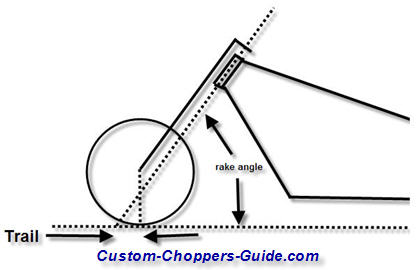Fork Rake Guide.
You'll need to understand fork rake if you want to build a chopper or even a frame for a stock configuration.
Often, rake is thought of as applying only to choppers, but all motorcycles have (fork) rake; it is inherent to the design concept of two wheeled vehicles.
The stock rake is generally around 30 degrees, give or take a few degrees, so that the forks do not go straight up and down but extend toward the front.
A motorcycle would be virtually uncontrollable if there were no rake to the forks. In a zero rake configuration, the front wheel would sit directly under the handlebars, not a very manageable configuration for on-road steering at all.
The definition of fork rake is the distance between an imaginary line drawn directly through the steering axis and the wheel center. The fork may be curved to achieve this rake, or it may be angled from the crown. Along with the concept of trail, how the motorcycle will steer and respond is defined.
Rake permits the addition of forks that are extended over stock length to be added to a chopper without raising the front end higher than desired.
The fork rake permits the front forks and attached front tire to extend to the front, sometimes to great lengths. This rake and extension combination has a big impact on turning radius and on-street handling of the motorcycle.
While many show choppers have forks with extreme extension measurements, the front tire configuration can result in a very bouncy feel when encountering bumps on the average roadway.
Therefore, most riders who build for street performance design choppers with less radical fork rakes.
It is more common in motorcycle and chopper design for front forks to be perfectly straight rather than employing any angle in the actual fork to create the desired rake.
The modern motorcycle designer usually introduces rake to the forks through angling the triple tree to the desired angle. This way, when the telescoping forks are mounted, the forks extend at the designed angle.
When describing a chopper, it is common for an owner to state the fork extension, expressed as "inches over stock", for example, "My chopper has a 12-over front end", meaning the forks are 12 inches over stock length. Rarely, however, does a motorcycle enthusiast state the amount of rake their motorcycle has in the neck.
Without knowing both the rake and extension of the forks, the listener doesn't get a very clear picture of the chopper's appearance.
In general, choppers are designed with both fork rake and fork extension to create the unique, low and long look associated with these custom motorcycles.
When designing a custom motorcycle, fork rake must be determined in conjunction with frame lowering, and longer forks.
Tire size and trail must also be considered to craft a design which will ride comfortably and safely as well as look great. Think about how you plan to use your custom bike, too, because ground clearance, turning radius, and spring when moving over bumpy roads all play a part in turning your design into the dream chopper you desire.
Read this Question and Answer for details on going from a 30 degree rake to a 45 degree rake using our Springer Fork Plans: Springer Rake Question from Rod and our our detailed answer (it's the last comment on the page with an image).

